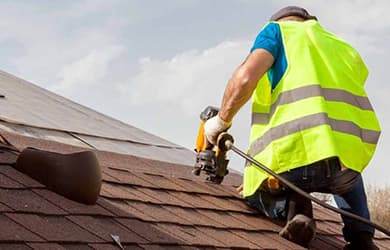Did you know that summer is an especially dangerous time for your home’s roof? Learn what steps to keep your roof in excellent condition with this brief guide.
How Has Your Roof Fared This Summer?
Summer is an especially dangerous time for roofs—how has your roof held up? The danger of winter’s snow and the accumulation of fall debris are widely acknowledged, but summer also poses unique problems to your roofing and gutters. Here are some aspects of summer weather that can damage your roof and what you can do to manage that damage.
HUMIDITY
The biggest way that the summer season will affect your roof is humidity. Humidity has harmful effects on construction, and that damage extends to your roof as well.
Humid air creates condensation buildup that pools underneath your shingles or tiles. This moisture is the source of many roofing problems. Whether it’s a simple deterioration or mold growth, humidity has serious effects. If you’re investigating how to find a roof leak, these pools of condensation are a prime suspect. In general, humidity is often the source of the leak your roofing and gutters may be experiencing.
THERMAL SHOCK
A second way that the summer weather conditions impact your roof is through thermal shock. Thermal shock is basically the temperature flux that your roof sustains every summer day. Your roof may heat up to 150 degrees Fahrenheit during summer days before rapidly cooling overnight. This extreme temperature flux rapidly expands and contracts your roof, shortening its life span.
HIGH HEAT
Ignoring thermal shock, the sheer heat of summer is enough to impact your roof. Summer heat breaks down your roofing material at an accelerated rate and causes it to fade and discolor. Keep in mind that roofs heat up dramatically even on casual summer days because of prolonged direct sun exposure.
UV EXPOSURE
Speaking of prolonged sun exposure, UV light plays a role in damages to roofing and gutters. A common misconception is that UV light is only an issue on sunny days, but it penetrates the cloud barrier. UV light impacts the quality of your roof by cracking wood, buckling shingles, and eroding your roof’s protective seal.
OUR RESIDENTIAL ROOF INSPECTION CHECKLIST
Not sure what you can do to keep your roofing and gutters in excellent shape? Just follow our roof inspection checklist! Any homeowner should be capable of trying this checklist out themselves, although we advise you to be careful—97% of roofing accidents happen by amateurs at home. We’ll mention the benefits of bringing in professionals later.
CLEAN THE GUTTERS
Dirt and debris accumulate in your gutters throughout the year. This debris accumulation in metal roof gutters continues throughout the summer. Whether it’s leaves or branches, there’s no shortage of debris that can clog up your gutters. Poorly maintained gutters can lead to roof leaks. If roof leaks are ignored, structural damage to your home’s ceiling, walls, and floors is possible. To avoid this, you should:
- Tighten downspouts
- Clear debris
- Test water run-off
- Check connecting joints
Alternatively, home improvement stores have begun to stock gutter guards, and these keep debris out of your gutters. Roofing and gutters work in tandem, so make sure to keep your gutters in excellent shape.
SCAN FOR MISSING SHINGLES OR TILES
Rain, thunderstorms, or hail damage roofing and gutters. Displaced or broken shingles or tiles cause water damage, which can lead to algae or mold formation. You can contact your local home improvement store for the material and try to replace it yourself, but roofing jobs are usually best left to experts.
Steps to find identify damaged roofing material are as follows:
- Take a ground-level inspection. Notice if any shingles or tiles have slid off or collapsed.
- Securely mount a ladder onto your house and make your way up to your roof. Make sure you have a partner with you to hold the ladder steady.
- Inspect your type of roofing. For shingle roofing, see if the shingles are warped, loose, or bent. For tiles, check if they’re cracked or loose.
- Take count of how many damaged shingles or tiles you have.
- Carefully come down from your roof. Again, make sure your ladder is secure and have your partner hold it steady.
This step of the roofing inspection checklist is dangerous if you’re untrained, so it’s best to leave it to experts.
CLEAN THE ATTIC
Did you know that the condition of your attic has a huge effect on your roofing and gutters? Keeping your attic clean is important for your roof’s ventilation, and keeps your home insulated. When cleaning out your attic, make sure that no pests have entered because they frequently cause damage to insulation. If your insulation is damaged, your attic will become a heat sink. This heat will slowly radiate into other rooms in your home and run up your utility costs. Outside of high utility costs, your attic impacts your roofing and gutters by affecting ventilation. A roof that doesn’t have room to breathe will trap moisture more easily.
TRIM DANGEROUS BRANCHES
We’ve seen far too many roofs damaged by tree branches that were long overdue for a trim. You can attempt trimming smaller branches alone—always call in professionals for bigger jobs. Even if you think that a tree or its branches look healthy, severe storms can cause collapsed branches that injure people and cost thousands in damages.
Call The Professionals At Stone Creek
If these steps sound intimidating on their own, call in professional roofing services. As mentioned throughout this piece, trying to do work on roofing and gutters as an amateur is dangerous. Reach out to Stone Creek Roofing instead.
We have an expert team that leaves all of our clients satisfied. Where other roofing companies always push for replacement, we understand that a simple repair is sometimes all you need. Regardless of the problem with your roofing and gutters, we can handle it.

